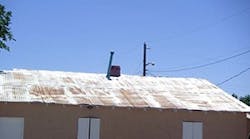Roofing systems have a finite life. Depending upon the composition of the roof system, it may be possible to extend roof life with an economically viable option.
There are many combinations that can yield long-lasting roof systems, but the purpose of this article is to dive into the basics of several common systems and available options.
The Right Surfacing for Low Slope Roofing Systems
Bituminous systems consist of asphalt or coal tar pitch as the adhesive and waterproofing and contain reinforcements of organic glass fiber or asbestos fibers. These systems are surfaced with aggregate embedded in a flood coat of bitumen, either hot- or cold-applied.
To prepare for resurfacing, use a high-pressure, low-volume wet vacuum to remove dirt and loose aggregate.
Surfacing options include:
- New flood coat of hot asphalt or pitch with new aggregate
- Solvent-based mastic and aggregate (sometimes called “resaturant”)
- Membrane and flashing replacement or repair with modified bituminous materials applied by torch, hot mopping, or a cold applied mastic or adhesive
- Asphalt emulsion applied with sprayed, chopped glass fibers, with a reflective roof coating such as acrylic- or aluminum-based products used to provide a finish surface after the emulsion coating
- For a smooth surface bituminous roof, asphalt-aluminum roof coatings (either solvent- or water-based) or a reflective white coating such as acrylics, urethanes, silicones, or ureas. An acrylic over an asphalt bleed blocking primer is an ideal combination.
Polymer-modified bituminous systems consist of polyester or glass fiber mats or scrims modified with polymers of atactic polypropylene (APP) or styrene-butadiene-styrene (SBS). They are frequently surfaced with factory-applied roofing granules.
Surfacing options include:
- Vacuum or power broom existing surface
- Heat from torching to soften the substrate – hot application of new cap sheet may require asphalt primer
- Granulated and smooth surfaced modified bitumen roofs can also be surfaced with aluminum-based coatings, as well as white reflective acrylics, urethanes, silicones, and ureas.
PageBreakSingle ply membrane systems may consist of thermoplastic or thermoset polymer sheets with or without internal reinforcement. These products are generally unsurfaced and compounded for weather resistance.
Selecting a proper coating can be complex, so seek the advice of a long-standing supplier with substrate specific products and specifications. You may need special primers to promote adhesion, especially if the polymer sheets are experiencing chalking. In many cases, small scale adhesion testing can be employed to determine the degree of adhesion that can be expected in full scale usage.
Many products such as acrylics, urethanes, silicones, ureas, and solvent-borne polymerics are suitable for recoating polymer single plies.
Closed cell sprayed–in-place polyurethane foam (SPF) is vulnerable to UV degradation and is generally coated with acrylic, silicone, or polyurethane coating. New coating systems may also use a thin reflective topcoat of polyvinylidene difluoride (PVDF) for added reflectivity. (Please note that PVDF coatings can also be used on many of the previous and subsequently discussed systems as a surface solution.) Punctures may be patched with a compatible caulk, such as silicone for a silicone-coated roof system.
Metal roof systems are based upon aluminum, zinc-aluminum coated steel, or polymer-coated steel. While they resist UV, they are vulnerable to corrosion such as in a salt air environment. Durable factory coatings of PVDF, polyester, or acrylic can be recoated with compatible field coatings.
Note that proper selection, following manufacturers’ recommendations for application and usage, and surface preparation are critical for a successful roof resurfacing project. Always make sure to mitigate any wet or deteriorating insulation and roofing, and remember that proper flashing repair is critical in long term performance.
For more information on how to determine compatibility between weathered substrates and new surfacings, see this primer at RoofCoatings.org.
Richard (Dick) L. Fricklas was technical director emeritus of the Roofing Industry Educational Institute prior to his retirement. He is co-author of The Manual of Low Slope Roofing Systems and continues to participate in seminars for the University of Wisconsin and RCI Inc., the Institute of Roofing, Waterproofing, and Building Envelope Professionals. His honors include the William C. Cullen Award and Walter C. Voss Award from ASTM, the J. A. Piper Award from NRCA, the William C. Correll award from RCI, and the James Q. McCawley Award from the MRCA. Dick holds honorary memberships in both ASTM and RCI Inc.
Considering a New or Replacement Roof?
Color isn’t the only factor in roof performance.
Preventive Roof Maintenance
What to look for when inspecting your roof system.
Efficacy of Cool Roofs Varies by City
Atmospheric feedback plays a big role in cool roof performance.


